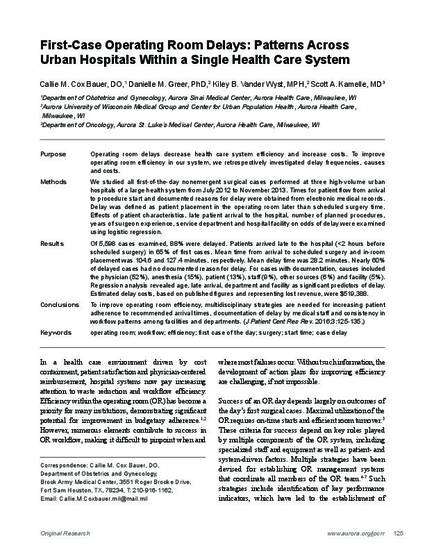
- operating room,
- workflow,
- efficiency,
- first case of the day,
- surgery,
- start time,
- case delay
Purpose
Operating room delays decrease health care system efficiency and increase costs. To improve operating room efficiency in our system, we retrospectively investigated delay frequencies, causes and costs.
Methods
We studied all first-of-the-day nonemergent surgical cases performed at three high-volume urban hospitals of a large health system from July 2012 to November 2013. Times for patient flow from arrival to procedure start and documented reasons for delay were obtained from electronic medical records. Delay was defined as patient placement in the operating room later than scheduled surgery time. Effects of patient characteristics, late patient arrival to the hospital, number of planned procedures, years of surgeon experience, service department and hospital facility on odds of delay were examined using logistic regression.
Results
Of 5,598 cases examined, 88% were delayed. Patients arrived late to the hospital (surgery) in 65% of first cases. Mean time from arrival to scheduled surgery and in-room placement was 104.6 and 127.4 minutes, respectively. Mean delay time was 28.2 minutes. Nearly 60% of delayed cases had no documented reason for delay. For cases with documentation, causes included the physician (52%), anesthesia (15%), patient (13%), staff (9%), other sources (6%) and facility (5%). Regression analysis revealed age, late arrival, department and facility as significant predictors of delay. Estimated delay costs, based on published figures and representing lost revenue, were $519,388.
Conclusions
To improve operating room efficiency, multidisciplinary strategies are needed for increasing patient adherence to recommended arrival times, documentation of delay by medical staff and consistency in workflow patterns among facilities and departments.
Cox Bauer CM, Greer DM, Vander Wyst KB, Kamelle SA. First-case operating room delays: patterns across urban hospitals within a single health care system. J Patient Cent Res Rev. 2016;3:125-35. doi: 10.17294/2330-0698.1265
